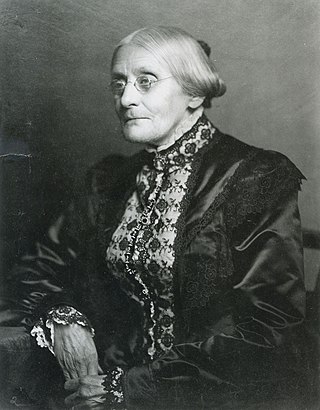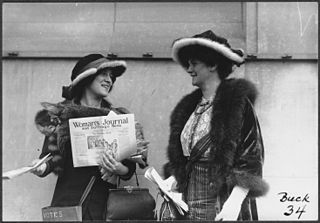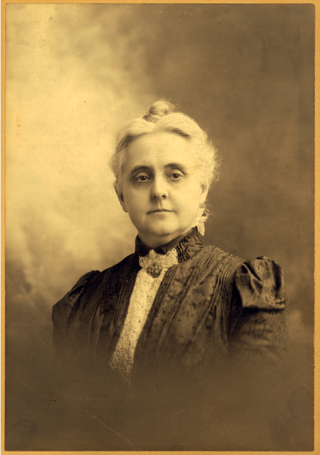
Susan B. Anthony was an American social reformer and women's rights activist who played a pivotal role in the women's suffrage movement. Born into a Quaker family committed to social equality, she collected anti-slavery petitions at the age of 17. In 1856, she became the New York state agent for the American Anti-Slavery Society.

Emily Howland was a philanthropist, humanitarian, and educator. She supported the education of African-Americans. She was also a strong supporter of women's rights and the temperance movement. Howland personally financed the education of many black students and contributed to institutions such as the Tuskegee Institute, Henry Damon Davidson's Centerville Industrial Institute, and Kowaliga Institute in Kowaliga, Alabama where Howland Hall was named for her.

Alice Stokes Paul was an American Quaker, suffragette, suffragist, feminist, and women's rights activist, and one of the foremost leaders and strategists of the campaign for the Nineteenth Amendment to the United States Constitution, which prohibits sex discrimination in the right to vote. Paul initiated, and along with Lucy Burns and others, strategized events such as the Woman Suffrage Procession and the Silent Sentinels, which were part of the successful campaign that resulted in the amendment's passage in August 1920.

Carrie Chapman Catt was an American women's suffrage leader who campaigned for the Nineteenth Amendment to the United States Constitution, which gave U.S. women the right to vote in 1920. Catt served as president of the National American Woman Suffrage Association from 1900 to 1904 and 1915 to 1920. She founded the League of Women Voters in 1920 and the International Woman Suffrage Alliance in 1904, which was later named International Alliance of Women. She "led an army of voteless women in 1919 to pressure Congress to pass the constitutional amendment giving them the right to vote and convinced state legislatures to ratify it in 1920". She "was one of the best-known women in the United States in the first half of the twentieth century and was on all lists of famous American women."

Mary Ellicott Arnold was an American social activist, teacher and writer best known for In the Land of the Grasshopper Song, the memoir she wrote with Mabel Reed on their experiences as Bureau of Indian Affairs employees, 1908–1909.

Lucretia Mott was an American Quaker, abolitionist, women's rights activist, and social reformer. She had formed the idea of reforming the position of women in society when she was amongst the women excluded from the World Anti-Slavery Convention held in London in 1840. In 1848, she was invited by Jane Hunt to a meeting that led to the first public gathering about women's rights, the Seneca Falls Convention, during which the Declaration of Sentiments was written.

Maud Wood Park was an American suffragist and women's rights activist.

Edna Buckman Kearns was a suffrage activist who worked on the 1915 and 1917 New York campaigns for votes for women, as well as the National Woman's Party campaign for the passage and ratification of the 19th amendment to the US Constitution.

Mary-Cooke Branch Munford was a Virginia activist for women's rights, civil rights, women's suffrage, and education.

Margaret Lillian Foley was an Irish-American labor organizer, suffragist, and social worker from Boston. Known for confronting anti-suffrage candidates at political rallies, she was nicknamed the "Grand Heckler."
Edna Frances Lamprey Stantial (1897–1985) was an American suffragist and archivist.

Women's suffrage was granted in Virginia in 1920, with the ratification of the Nineteenth Amendment to the United States Constitution. The General Assembly, Virginia's governing legislative body, did not ratify the Nineteenth Amendment until 1952. The argument for women's suffrage in Virginia began in 1870, but it did not gain traction until 1909 with the founding of the Equal Suffrage League of Virginia. Between 1912 and 1916, Virginia's suffragists would bring the issue of women's voting rights to the floor of the General Assembly three times, petitioning for an amendment to the state constitution giving women the right to vote; they were defeated each time. During this period, the Equal Suffrage League of Virginia and its fellow Virginia suffragists fought against a strong anti-suffragist movement that tapped into conservative, post-Civil War values on the role of women, as well as racial fears. After achieving suffrage in August 1920, over 13,000 women registered within one month to vote for the first time in the 1920 United States presidential election.

Elizabeth Glendower Evans was an American social reformer and suffragist.

Elizabeth Dabney Langhorne Lewis was the founder of the Lynchburg Equal Suffrage League and vice-president of the Equal Suffrage League of Virginia. She was also one of the founders of the Virginia League of Women Voters.

Mariana Wright Chapman was an American social reformer and women's rights activist. Her most active work was in the direction of prison reform and equal rights for women. Chapman was well-known through her work in the Hicksite Society of Friends, of which she was one of the organizers, and because of her advocacy of woman's suffrage. Chapman was president of the Woman Suffrage Association of Brooklyn, which office she resigned to become president of the New York State Woman Suffrage Association.

Sophie Gooding Rose Meredith was an American suffragist.
Lillie Mary Clinedinst was an American suffragist and labor activist.

Judith Anna Powell Rice was an American educator and activist in the causes of temperance, abolition, social purity, and women's suffrage.
















